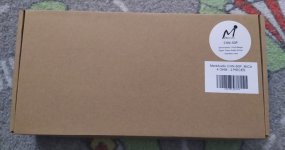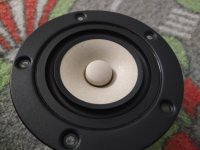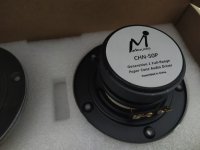tens of thousands of our favorite recordings were mixed in a studio with monitors on top of a mixing desk/console.........a non issue
I mix, I'd argue stuff comes out well in spite of desks. They are a big problem for me and I ultimately just got rid of the thing and use a small board sitting on a keyboard stand.
Well, they are not in the right thread. Mission impossible will become possible, because CHN-50P, being "the brain" will not be alone. It will be backed up by some 10" muscles (WaoW!) 😀
Not quite the desktop setting, but... 😉
I made a filter for a PS95-8 in a box with a passive radiator for a friend. It sounded nice. Lots of detail.



You can listen to it here:
On the bench tonight is a passive filter for a friend’s single driver fullrange speaker. He built it with a repurposed bamboo curio box and a Dayton PS95-8 driver and some Aliexpress passive radiators in the back.
I measured it and simulated a filter in Xsim and arrived at a BSC using 1mH and 7ohm resistor followed by a 0.33mH and 2.2uF 2nd order low pass to tame the rising response. It measures really well - almost monitor like now and with a slight down tilt. If anyone wants to use this filter - make the speaker cabinet about 6in wide to match the baffle step correction. Otherwise the...
I measured it and simulated a filter in Xsim and arrived at a BSC using 1mH and 7ohm resistor followed by a 0.33mH and 2.2uF 2nd order low pass to tame the rising response. It measures really well - almost monitor like now and with a slight down tilt. If anyone wants to use this filter - make the speaker cabinet about 6in wide to match the baffle step correction. Otherwise the...
You can listen to it here:
Well I tried more reflector shapes and couldn't improve upon the "snow-cone" for MAOP10. Scarily pointy; an accident did occur when I rushed to put it away before work -- I had to massage the cone a bit.... It joined the hurt and endangered MAOP5, F200A, and W300Aii I had rescued from Idlefish Market (paying for each pair less than the good mate might have fetched alone). Afterwards I listened to it and heard a glitch in my routine test track I had never noticed before. Turned out to be in the music source.
I post it here as a "best possible audiophile desktop" candidate despite the restriction that the omni-directional snow-cone tip be near ear height so direct driver sound (out of time- and phase-alignment with the reflected sound) is ~90° off-axis and naturally attenuated. Another possibility is of course LX MAOP5/10.
The internal 1.5m tri-fold TL (quarterwave something-or-other) added useful, clear bass down to ~50hz (driver still less than 100 hours).
(Snow-cone made from my best cardboard box, curvature shaped by rubbing across tabletop edge; the word inside is "crab" 蟹).
If only it did conic surfaces... spherical dustcap or simple omni reflector like the snow-cone below. The PrimeRadiants are effectively half-space omni-directional per tweeter on-axis FR.You can play with this with ideal drivers and flat shapes in vituixcad.
MAOP10 had been unavailable since Covid, until 11/1 pre-Singles Day. I snatched it and also China's first pair of MA200, which was HF-humped on-axis but very flat off-axis ~30-40° out to 15khz -- both listened-to as desktop-omni and confirmed using umik-1/REW. I was going to buy a spare MA200 until I heard the MAOP10. The...
Last edited:
A sphere might work quite well as a reflector. Safer and easier to find - maybe a large plastic Xmas tree ornament?
I once had an idea for a Cornu BLH and a spherical reflector as a coffee table. I suppose the BLH could be replaced by a simple BR and use something like a 3.5in driver on a prismatic column with top firing driver and a sphere above it. That would be a relatively easy project to prototype on foam core. Develop filter for it compensate for the unique upward pointing driver and sphere reflector.

I once had an idea for a Cornu BLH and a spherical reflector as a coffee table. I suppose the BLH could be replaced by a simple BR and use something like a 3.5in driver on a prismatic column with top firing driver and a sphere above it. That would be a relatively easy project to prototype on foam core. Develop filter for it compensate for the unique upward pointing driver and sphere reflector.
I kept losing ping-pong balls (probably too small but see below) and didn't want to use my souvenir baseball.... Just tried again larger round shapes but most very-HF, produced near the dustcap, bounced down instead of out. Before the dangerously-close big pointy snow-cones I had tried smaller cones cut from paper cups, then cooked salted goose eggs, then added "piece-of-tape" pointy goaties (to excellent effect). Still room for improvement above 10khz, but (listened OMNI) already remarkably flat above 120hz all the way to 10khz. Surprisingly, I could hear low-SPL-played 11.7khz tone omni. The challenge is to extend/raise very-HF bounce without enlarging the remaining ~8khz trace of the original HF plateau. (In my demented scoring the difference between A+ and 1-demerit A.) As for low bass, by enlarging the TL to 2m-long, 30L (from 1.5m, 23L) the 40s are in, though not (yet) quite as powerful (on Engleskyts very lowest organ chord) as, say, my 3.75L Alpair5.2 TLonken (maybe the .2 had something to do with it cf. 10.2 Sibelius story). Floorstander though.A sphere might work quite well as a reflector. Safer and easier to find - maybe a large plastic Xmas tree ornament?
Last edited:
This would be so cool if the Cornu tabletop were transparent -- say heavily-textured plexi/glass. I'm planning to do PrimeRadiant 3 (JBL 2226H with 3 B&O tweeters) this way by/before the sofa, wire-meshed.I once had an idea for a Cornu BLH and a spherical reflector as a coffee table. I suppose the BLH could be replaced by a simple BR and use something like a 3.5in driver on a prismatic column with top firing driver and a sphere above it. That would be a relatively easy project to prototype on foam core. Develop filter for it compensate for the unique upward pointing driver and sphere reflector.
View attachment 1399482
They look great! What have you used there?I made a MLTL with the W4-1052SD that needed two small notches.
I remade the salted egg goaties, one end obtuse-ish and the other end acute-ish. Obtuse didn't work well tonally, and acute initially sounded tonally very close to snow-cone but with more detail. None of my steamer racks were the right height so I ended up adjusting the egg height by hand while playing music. Three times I stopped at (eyeball) 7mm tip-to-dustcap as optimal (clearest transcients, farthest away). Then I compared sinewave 2/5/8/10khz and ~7mm gave (no less than) the maximum reflected sound, in every case. Fortuitously, with this gap the frequency response 2-9khz was very nearly flat, perhaps slightly brighter than snow-cone, and 9-11khz clearly better (less diminished). Played music all day so time to put things away (very carefully!).Before the dangerously-close big pointy snow-cones I had tried smaller cones cut from paper cups, then cooked salted goose eggs, then added "piece-of-tape" pointy goaties (to excellent effect). Still room for improvement above 10khz, but (listened OMNI) already remarkably flat above 120hz all the way to 10khz. Surprisingly, I could hear low-SPL-played 11.7khz tone omni. The challenge is to extend/raise very-HF bounce without enlarging the remaining ~8khz trace of the original HF plateau.
(Ear-position/head-angle is critical and must be constantly re-callibrated using a very directional, very high frequency tone to ensure constant/max sensitivity for each listening test. After a while hearing becomes over-saturated and must take a long rest.)
Last edited:
Hello, this is plaster on your walls ?
Everything that is in contact with it is instantly white powderded ?
I was looking at the celestion an3510's I have, and there's fairly minimal obstruction on the back side since they are neodymium, that mesh is just a mesh to keep things out from under the spider. I hooked them up in little sealed cabinets and they sounded pretty good. There are a lot of neodymium drivers these days.
 I never tried it on a desktop but seems like a reasonable idea.
I never tried it on a desktop but seems like a reasonable idea.
That is real stone called onyx. It's cut down to 6mm thick, and glued to 6mm plywood.They look great! What have you used there?
Dear enthusiasts and experts of DIY, would you mind and care explaining how and why those distortions happen in certain speaker designs and how they are eliminated ??
I would also be very curious to know in simple words, what happens "sonically" as a result of those distortions ??
Thank you in advance guys
I would also be very curious to know in simple words, what happens "sonically" as a result of those distortions ??
Thank you in advance guys
Excerpts from the Red Shift: Doppler distortion in loudspeakers:
So while I see some larger "full range" drivers are designed with Xmax of 8 mm this is 8x more than how they should be used to avoid IMD.
In other words in the audiophile desktop we are discussing here the drive that is responsible for playing the most significant for quality 1+ kHz area must be strictly limited to 1 mm displacement at low frequencies. It means, it should be allowed to play down to 100 Hz only at very low volume, and if more normal volume is desirable it should be high passed, I don't know, maybe at 200 Hz or so.The results were intriguing. Distortion of the flute was gross at 10mm peak diaphragm displacement and not in the least bit euphonic. On the contrary, Doppler made the sound as harsh as you might expect of a distortion mechanism that introduces intermodulation products. At 3.16mm peak displacement (below Fryer's suggested detectability threshold) the distortion level was obviously lower but still clearly audible; and even at 1mm it could still be heard affecting the flute's timbre and adding "edge."
So while I see some larger "full range" drivers are designed with Xmax of 8 mm this is 8x more than how they should be used to avoid IMD.
- Home
- Loudspeakers
- Full Range
- How to build the best possible audiophile desktop?


